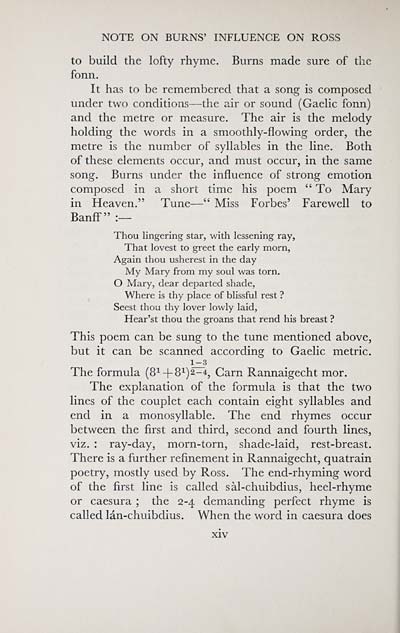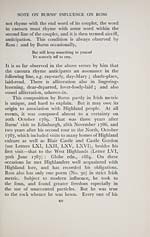Matheson Collection > Gaelic songs
(20)
Download files
Complete book:
Individual page:
Thumbnail gallery: Grid view | List view

NOTE ON BURNS' INFLUENCE ON ROSS
to build the lofty rhyme. Burns made sure of the
form.
It has to be remembered that a song is composed
under two conditions — the air or sound (Gaelic fonn)
and the metre or measure. The air is the melody
holding the words in a smoothly-flowing order, the
metre is the number of syllables in the line. Both
of these elements occur, and must occur, in the same
song. Burns under the influence of strong emotion
composed in a short time his poem " To Mary
in Heaven." Tune — " Miss Forbes' Farewell to
Banff" :—
Thou lingering star, with lessening ray,
That lovest to greet the early morn,
Again thou usherest in the day
My Mary from my soul was torn.
O Mary, dear departed shade,
Where is thy place of blissful rest ?
Seest thou thy lover lowly laid,
Hear'st thou the groans that rend his breast ?
This poem can be sung to the tune mentioned above,
but it can be scanned according to Gaelic metric.
1-3
The formula (8 1 + 8 1 )2-4 J Cam Rannaigecht mor.
The explanation of the formula is that the two
lines of the couplet each contain eight syllables and
end in a monosyllable. The end rhymes occur
between the first and third, second and fourth lines,
viz. : ray-day, morn-torn, shade-laid, rest-breast.
There is a further refinement in Rannaigecht, quatrain
poetry, mostly used by Ross. The end-rhyming word
of the first line is called sàl-chuibdius, heel-rhyme
or caesura ; the 2-4 demanding perfect rhyme is
called lan-chuibdius. When the word in caesura does
to build the lofty rhyme. Burns made sure of the
form.
It has to be remembered that a song is composed
under two conditions — the air or sound (Gaelic fonn)
and the metre or measure. The air is the melody
holding the words in a smoothly-flowing order, the
metre is the number of syllables in the line. Both
of these elements occur, and must occur, in the same
song. Burns under the influence of strong emotion
composed in a short time his poem " To Mary
in Heaven." Tune — " Miss Forbes' Farewell to
Banff" :—
Thou lingering star, with lessening ray,
That lovest to greet the early morn,
Again thou usherest in the day
My Mary from my soul was torn.
O Mary, dear departed shade,
Where is thy place of blissful rest ?
Seest thou thy lover lowly laid,
Hear'st thou the groans that rend his breast ?
This poem can be sung to the tune mentioned above,
but it can be scanned according to Gaelic metric.
1-3
The formula (8 1 + 8 1 )2-4 J Cam Rannaigecht mor.
The explanation of the formula is that the two
lines of the couplet each contain eight syllables and
end in a monosyllable. The end rhymes occur
between the first and third, second and fourth lines,
viz. : ray-day, morn-torn, shade-laid, rest-breast.
There is a further refinement in Rannaigecht, quatrain
poetry, mostly used by Ross. The end-rhyming word
of the first line is called sàl-chuibdius, heel-rhyme
or caesura ; the 2-4 demanding perfect rhyme is
called lan-chuibdius. When the word in caesura does
Set display mode to: Large image | Transcription
Images and transcriptions on this page, including medium image downloads, may be used under the Creative Commons Attribution 4.0 International Licence unless otherwise stated. ![]()
| Early Gaelic Book Collections > Matheson Collection > Gaelic songs > (20) |
|---|
| Permanent URL | https://digital.nls.uk/76606747 |
|---|
| Description | Items from a collection of 170 volumes relating to Gaelic matters. Mainly philological works in the Celtic and some non-Celtic languages. Some books extensively annotated by Angus Matheson, the first Professor of Celtic at Glasgow University. |
|---|
| Description | Selected items from five 'Special and Named Printed Collections'. Includes books in Gaelic and other Celtic languages, works about the Gaels, their languages, literature, culture and history. |
|---|

